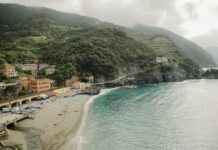The alert was given at the end of August by «sentinel» divers, connoisseurs of these multicolored coral forests off the second city of France.
«It hurts the heart, the deterioration is super fast, only two months ago we dived here to explore this magnificent fully colored forest», laments Tristan Estaque, in charge of scientific missions at Septentrion environnement, aboard the boat of this association. studying Mediterranean marine ecosystems.
Meanwhile, a major marine heat wave hit the western Mediterranean this summer with water temperatures «4 to 5 degrees» above normal, according to Mercator Ocean International, the organization leading Europe’s ocean monitoring service. The water temperature rose up to 30 degrees in places.
– «ghost forest» –
Coming back from an exploratory dive on this September day, Tristan Estaque described to AFP an apocalyptic landscape under water, a «ghost forest»: «You have to imagine a tree where there are no more leaf, more bark».
In his hands, a piece of dead gorgonian, a small beige tree with bare branches: «Normally on this species there is a purple tissue full of polyps», he laments. Under the pressure of continuous and intense heat, the gorgonian dies and its tissue turns gray and crumbles to dust.
According to the statements of Septentrion environment, near Marseille «70 to 90% of the population of red gorgonians» in the zone of 10 to 20 meters are dead.
The few living tissues taken (about 20% of each «tree») are collected and labeled on the boat, for genetic analysis.
Gorgonian mortality has also been observed on the Spanish coast, in the Toulon region or even around the Italian island of Sardinia, according to Stéphane Sartoretto, who participates in species monitoring for the French Research Institute for Exploitation. from the sea (Ifremer).
In the Calanques National Park, these spectacular creeks scattered on the coast near Marseille, it was especially intense due to the shallow implantation of the gorgonians, only six meters from the surface in certain areas. In the Balearic Islands, they live deeper, at 40 meters, and have therefore been less impacted, according to Mr Sartoretto.
– Risk of disappearance –
In addition to the red gorgonian, sponges or even bivalves were well affected, he notes, as well as a fish, the mostelle.
The first well-documented episode of gorgonian mortality was noted in 1999, notes Mr. Sartoretto, «but the heat stroke was in the fall, whereas there it happened very early, so we are not at the protected from new heat strokes in October…»
The low temperatures observed in recent days can perhaps «preserve those that were not affected», according to Solène Bastard-Gogain, without being sure that this will stop the phenomenon because «if the heat has favored a pathogen, it is likely “that he is still present.
For the destroyed gorgonians, the scientists are pessimistic: «As for a forest fire on the ground, the resilience is very low for the gorgonians, they will take decades to regenerate», deplores Mr. Sartoretto, also underlining the low reproduction rate of these marine animals.
«We can ask ourselves the question of their disappearance if the heat strokes are repeated too often, and in this case, what will happen?» Asks the scientist. Because gorgonians are «engineering species, which structure the seabed».
They constitute «real animal forests which shelter 15 to 20% of the species known in the Mediterranean», according to the Calanques National Park.
If this sea covers less than 1% of the ocean surface of the planet, it is home to «18% of all known marine species», according to a report by the network of Mediterranean experts on climate change (Medecc), and already presents » the highest proportion of threatened marine habitats in Europe».
The «sea heat wave» also affected other species, especially mussels: in Spain, 150 tonnes of commercial mussels and 1,000 tonnes of farmed mussels were lost this summer.














